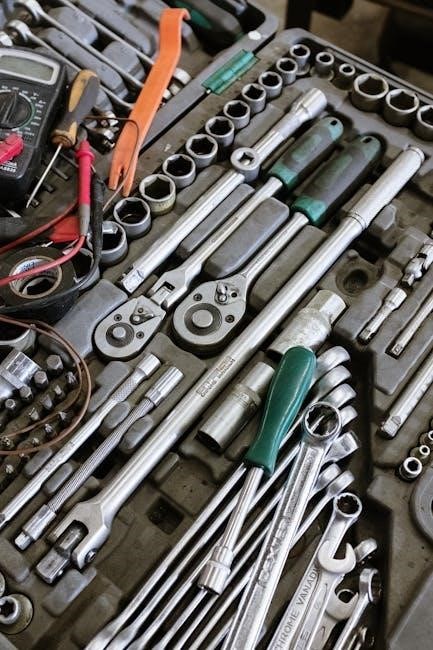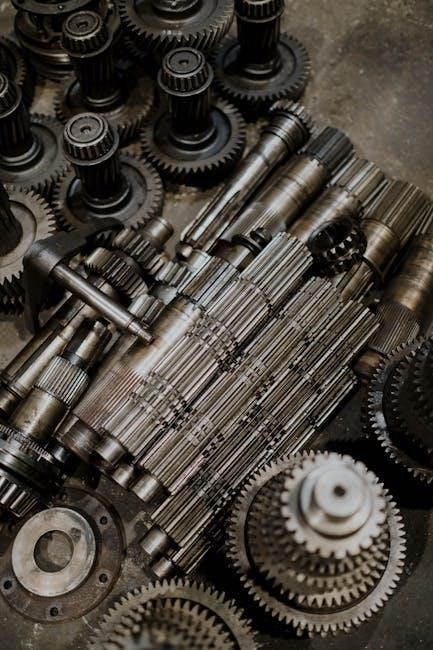Steelcase cubicle assembly requires careful planning and organization. Start by gathering all tools and materials, ensuring nothing is missing. Unpack components and organize them logically. Read the manual thoroughly, understanding each step before beginning. Prioritize safety, clearing the workspace and wearing protective gear. Begin with the frame, ensuring stability and proper alignment. Attach panels and work surfaces securely, checking for levelness. Install storage units and accessories according to instructions. Regularly inspect and adjust for stability and alignment. Seek assistance if needed, especially with heavy parts. Plan ample time to avoid rushing and ensure a sturdy, well-assembled cubicle. Refer to troubleshooting resources if issues arise during assembly.
1.1 Overview of Steelcase Cubicles
Steelcase cubicles are renowned for their durability, modular design, and ergonomic features, making them a popular choice for modern office environments. These cubicles are designed to provide privacy, comfort, and flexibility, catering to diverse workplace needs. With a focus on adaptability, Steelcase cubicles offer customizable layouts, allowing businesses to tailor workspaces to specific roles or team requirements. Their robust construction ensures long-term reliability, while sleek designs enhance office aesthetics. Available in various sizes and configurations, Steelcase cubicles are ideal for open-plan offices, collaborative spaces, or private workstations. They often feature integrated storage solutions, cable management systems, and adjustable components to support worker productivity and well-being. By combining functionality and style, Steelcase cubicles create efficient and inspiring work environments, making them a preferred option for organizations seeking high-quality office furniture.
1.2 Importance of Proper Assembly

Proper assembly of Steelcase cubicles is crucial for ensuring stability, functionality, and safety in the workplace. Improperly assembled cubicles can lead to structural instability, potentially causing accidents or injuries. Correctly following the assembly instructions guarantees that all components fit securely, maximizing the product’s durability and performance. A well-assembled cubicle also enhances the overall aesthetic appeal of the office, contributing to a professional environment. Additionally, proper assembly ensures compliance with manufacturer guidelines, preserving the product warranty and longevity. Misaligned or loose parts can result in frequent repairs, increasing maintenance costs over time. Therefore, adhering to the provided instructions and taking the time to assemble each component meticulously is essential for achieving a safe, efficient, and visually appealing workspace that meets both functional and ergonomic standards.
1.3 Tools and Materials Required
Assembling Steelcase cubicles requires specific tools and materials to ensure a smooth and successful process. Essential tools include an Allen wrench, screwdrivers (both Phillips and flathead), a mallet, and measuring tape. Additional items like clamps, a level, and safety gloves are recommended for stability and safety. Materials provided typically include pre-drilled panels, frame components, screws, bolts, and connectors. Ensure all parts are accounted for by cross-referencing the inventory list with the contents of the shipment. Organize components by type and label them for easy identification during assembly. Verify that all tools are within reach to minimize interruptions. Proper preparation of tools and materials saves time and reduces the risk of errors, ensuring a professional and durable final product. Familiarize yourself with each item’s purpose to streamline the assembly process and achieve optimal results.

Preparation for Assembly

Begin by unpacking and organizing all components, verifying completeness. Read the manual carefully, understanding each step. Ensure the workspace is clear and tools are ready. Safety gear like gloves is essential. Plan the layout and prepare materials for efficient assembly. Organize parts by type and label them for easy access. Double-check all instructions and safety guidelines before starting. Proper preparation ensures a smooth and successful assembly process.
2.1 Unpacking and Organizing Components
Begin by carefully unpacking all boxes and crates, ensuring no damage occurs during the process. Verify the completeness of components against the provided inventory list. Organize parts into categories, such as frames, panels, and hardware, to streamline assembly. Use labels or bins to keep items like screws, bolts, and connectors easily accessible. Ensure tools like Allen wrenches or screwdrivers are within reach. Clear the workspace to avoid clutter and prevent losing small parts. Arrange larger components, such as work surfaces or shelves, in a logical order based on the assembly sequence. Double-check the manual for specific unpacking instructions, especially for fragile or pre-assembled pieces. Proper organization saves time and reduces the risk of missing or misplaced parts during assembly.
2.2 Understanding the Assembly Manual
Thoroughly review the Steelcase assembly manual before starting. Familiarize yourself with its layout, symbols, and terminology. The manual provides step-by-step instructions, diagrams, and safety tips. Pay attention to the sequence of assembly, as it is designed to ensure stability and proper fit. Look for specific instructions tailored to your cubicle model, as configurations may vary. Check for a detailed parts list to confirm all components are included. Use the manual’s visual guides to identify hardware and tools needed for each step. Note any warnings or precautions to avoid damage or injury. If unclear, refer to online resources or video tutorials for clarification. Keep the manual handy during assembly for quick reference. Understanding it fully will streamline the process and minimize errors.
2.3 Safety Precautions and Guidelines
Before starting the assembly, ensure a safe working environment. Clear the workspace of clutter and tripping hazards. Wear protective gear, such as gloves and safety glasses, to prevent injuries. Use a ladder or step stool cautiously when reaching high areas. Always lift heavy components with a second person to avoid strain or accidents. Keep the area well-ventilated and free from children or pets. Follow the manual’s safety tips and warnings, as they are designed to prevent damage and injury. Be mindful of sharp edges or points on metal components. Avoid over-tightening bolts, as this could damage the structure. If unsure about any step, consult additional resources or seek professional help. Stay alert and avoid rushing to maintain focus and safety throughout the assembly process. Proper safety measures ensure a successful and injury-free installation of your Steelcase cubicle.

Assembly Process
Begin with assembling the frame, ensuring stability and alignment. Install panels and work surfaces securely, followed by storage units and accessories. Follow manual instructions carefully.
3.1 Assembling the Frame and Structure
Start by assembling the frame, which serves as the foundation of the cubicle. Carefully unpack and identify the vertical posts, horizontal beams, and connecting hardware. Use the Allen wrench to secure the posts to the floor, ensuring they are evenly spaced and aligned. Next, attach the horizontal beams to the top of the posts, tightening the bolts firmly. Double-check the frame’s stability by ensuring all parts are level and securely fastened. If the frame is unstable, adjust the bolts or check for missing hardware. Once the frame is sturdy, proceed to attach the panels and other components. Always refer to the assembly manual for specific torque settings and alignment guidelines to avoid structural issues later on.

3.2 Installing Panels and Dividers
After assembling the frame, begin installing the panels and dividers. Align each panel with the designated slots on the frame, ensuring proper fitment. Use the provided screws to secure the panels tightly, starting from the bottom and working upwards. For dividers, attach them between panels to create separate workspaces. Make sure all panels are level and evenly spaced. Tighten all connections firmly to avoid instability. If a panel doesn’t fit, check for correct alignment or consult the manual. Once installed, verify that the panels are secure and the dividers are properly positioned. This step is crucial for creating a functional and private workspace. Avoid over-tightening, as this may damage the panels or frame. Double-check the alignment before moving on to the next step.
3.3 Attaching Work Surfaces and Shelves
Attaching work surfaces and shelves is a critical step in your Steelcase cubicle assembly. Begin by aligning the work surface with the brackets attached to the frame. Ensure it is level and properly positioned before securing it with the provided screws. Once the work surface is in place, move on to the shelves. Install shelves by attaching them to the designated connectors on the panels or frame. Tighten all screws firmly to ensure stability. If necessary, use clamps or a second pair of hands to hold shelves steady during installation. Double-check the alignment of both the work surface and shelves before finalizing. Ensure all connections are secure to prevent any wobbling or instability. Refer to the manual for specific instructions on shelf placement and weight limits. Proper installation ensures a functional and durable workspace.
3.4 Integrating Storage Units and Accessories
Integrating storage units and accessories enhances functionality and personalization of your Steelcase cubicle. Begin by identifying the designated areas for storage, such as under the work surface or on adjacent panels. Attach file cabinets, drawers, or shelves using the provided brackets and screws, ensuring they align perfectly with the frame. For overhead storage, install bins or trays by securing them to the top connectors. Use cable management systems to organize wires and keep the workspace clutter-free. Double-check all connections to ensure stability and proper fitment. Refer to the manual for specific torque specifications and hardware requirements. Once installed, test the storage units by gently pulling or opening them to confirm secure attachment. Proper integration ensures a tidy, efficient, and ergonomic workspace tailored to your needs.

Adjustments and Customization
Adjustments and customization are crucial for optimizing your Steelcase cubicle. Modify heights, align components precisely, and tailor the layout to suit your workflow. Incorporate ergonomic features for comfort and efficiency, ensuring a personalized workspace that meets your specific needs and preferences.
4.1 Adjusting Height and Alignment
Adjusting the height and alignment of your Steelcase cubicle is essential for ensuring proper functionality and comfort. Begin by referring to the assembly manual for specific height adjustment instructions, as different models may vary. Use an Allen wrench or the provided adjustment tool to modify the height of the frame and work surfaces. Ensure all legs and supports are evenly adjusted to maintain balance. Check the alignment of panels and dividers, making sure they fit securely and are level. If necessary, tighten or loosen screws to achieve the desired position. After adjustments, perform a final inspection to confirm stability and proper alignment. This step ensures your cubicle is both functional and visually appealing, providing a comfortable workspace tailored to your needs.
4.2 Customizing Layout and Configuration
Customizing the layout and configuration of your Steelcase cubicle allows you to tailor the workspace to your specific needs. Start by assessing the available space and desired functionality. Use the modular components to rearrange panels, work surfaces, and storage units for optimal workflow. Consider integrating ergonomic features, such as adjustable shelves or cable management systems, to enhance comfort and efficiency. Refer to the assembly manual for guidance on reconfiguring parts without compromising structural integrity. Experiment with different configurations to achieve a balance between privacy and collaboration. For example, add dividers to minimize distractions or expand the layout to accommodate team workspaces. Ensure all adjustments align with the cubicle’s design specifications to maintain stability. This customization step ensures your Steelcase cubicle is both functional and personalized, creating a productive and comfortable work environment tailored to your preferences.
4.3 Incorporating Ergonomic Features
Incorporating ergonomic features into your Steelcase cubicle is essential for creating a comfortable and efficient workspace. Start by ensuring the work surface is at an optimal height, allowing for proper posture. Adjust the desk to a standing or sitting position based on your preference. Install shelves or storage units at convenient heights to minimize reaching or bending. Consider adding cable management systems to keep cords organized and reduce tripping hazards. Use adjustable lighting options to customize illumination levels. Incorporate seating solutions, such as ergonomic chairs, to support proper spinal alignment. Finally, personalize the layout to promote workflow efficiency, ensuring frequently used items are within easy reach. By integrating these ergonomic elements, you can create a workspace that supports productivity, reduces fatigue, and enhances overall well-being.

Troubleshooting Common Issues
Identify common issues like misalignment or instability. Solve alignment problems by adjusting frames. Check stability by ensuring panels are secure. Address damaged parts by replacing them. Refer to manual or support for unresolved issues.
5.1 Identifying and Solving Alignment Problems
Alignment issues are common during Steelcase cubicle assembly. Start by inspecting the frame for unevenness. Use a level to ensure all panels and surfaces are properly aligned. If misaligned, check connections and tighten loose screws. Refer to the manual for specific torque settings. For persistent issues, adjust the feet or base plates to level the structure. If panels are uneven, verify that all clips and brackets are securely attached. Consult the troubleshooting guide or video resources for visual assistance. If alignment problems persist, consider reassembling the affected section. Ensure all parts are correctly oriented and aligned before moving forward. Proper alignment is critical for stability and functionality, so take the time to address any discrepancies thoroughly.
5.2 Addressing Stability and Balance Concerns
Ensuring the stability and balance of your Steelcase cubicle is essential for safety and functionality. Begin by checking the workspace to confirm it is level and even. Inspect the frame and panels for proper connections, as loose joints can cause instability. Use a level tool to verify alignment, especially after assembling the structure. If the cubicle feels unsteady, adjust the feet or base plates to compensate for uneven surfaces. Tighten all screws and bolts firmly, ensuring no hardware is loose. Double-check panel connections to prevent wobbling. If issues persist, refer to the assembly manual for specific torque settings and alignment guides. Addressing stability concerns early prevents potential hazards and ensures a secure workspace; Use resources like troubleshooting guides or videos for additional assistance if needed.

5.3 Fixing Damaged or Missing Components
If components are damaged or missing during assembly, address the issue promptly to ensure structural integrity. Inspect the damaged part to determine if it can be repaired or if replacement is necessary. Refer to the assembly manual for a detailed list of components and their identification numbers. Contact Steelcase customer support or authorized dealers for replacements, providing the specific part number for accuracy. For minor damage, such as scratched or dented panels, consider touch-up kits or cosmetic repairs. If a part is missing, double-check the packaging or consult the manual to confirm it was included. Use original Steelcase replacement parts to maintain warranty validity and ensure compatibility. Avoid using substitute parts, as they may compromise stability or functionality. Regularly inspect components during assembly to identify and address issues early. Properly dispose of damaged parts and follow Steelcase guidelines for returns or exchanges.

Maintenance and Upkeep
Regularly clean surfaces, inspect for wear, and tighten loose connections. Replace damaged or worn parts promptly with genuine Steelcase components. Ensure proper alignment and stability during use.
6.1 Cleaning and Sanitizing the Cubicle
Regular cleaning and sanitizing of your Steelcase cubicle are essential for maintaining a hygienic and professional workspace. Start by dusting all surfaces, including frames, panels, and shelves, using a soft, dry cloth. For tougher stains or spills, use a mild detergent diluted in water, applied with a non-abrasive sponge or cloth. Avoid harsh chemicals or abrasive cleaners, as they may damage finishes or materials. Pay special attention to high-touch areas, such as handles, drawers, and work surfaces, using a disinfectant spray or wipes. For fabric panels, vacuum gently and spot clean stains using a fabric-specific cleaner. Sanitize electronic components, like keyboards and monitors, with alcohol-free wipes. Finally, organize the cubicle to ensure cleanliness and functionality, and inspect for any signs of wear or damage. Regular maintenance ensures longevity and a comfortable working environment.
6.2 Regular Inspections and Checks
Regular inspections are crucial to ensure the longevity and functionality of your Steelcase cubicle. Begin by checking the stability of the structure, ensuring all connections are secure and tightened properly. Inspect panels and shelves for any signs of damage, warping, or misalignment. Verify that all moving parts, such as drawers and hinges, are functioning smoothly; Look for wear and tear on surfaces, including scratches or fading, which may indicate the need for touch-ups or replacements. Check for any loose screws or bolts and tighten them as needed. Additionally, ensure that all cables and wires are neatly organized and secured to avoid tripping hazards or damage. Schedule periodic inspections, ideally every 3-6 months, to maintain the cubicle’s condition and address any issues promptly. Keep a record of inspections to track maintenance and plan for future updates or repairs. This proactive approach ensures a safe and efficient workspace.
6.3 Updating or Replacing Parts
Updating or replacing parts on your Steelcase cubicle ensures optimal performance and extends its lifespan. Always refer to the Steelcase assembly manual or online resources for guidance on compatible parts. For damaged or outdated components, visit the Steelcase website or authorized dealers to purchase genuine replacements. When replacing panels, shelves, or storage units, ensure they align with the existing structure for a seamless fit. Use the provided assembly tools and follow the manufacturer’s instructions to avoid damaging the cubicle. For complex updates, consider consulting assembly videos or contacting Steelcase customer support. Regularly updating your cubicle with new features or designs can enhance functionality and aesthetics; If unsure about compatibility or installation, seek professional assistance to avoid errors. Keep track of any recalls or updates from Steelcase to ensure your cubicle remains safe and up-to-date;
Successful assembly ensures a functional and safe workspace. Follow instructions carefully and consult resources for further assistance. Proper assembly enhances productivity and longevity of your Steelcase cubicle.
7.1 Summary of Key Assembly Steps
Assembly begins with unpacking and organizing components, ensuring all parts are accounted for. Start by constructing the frame, following the manual’s guidance for stability. Attach panels and dividers securely, aligning them properly. Install work surfaces and shelves, ensuring they are level and firmly fastened. Integrate storage units and accessories according to the design layout. Conduct regular inspections to maintain alignment and stability, addressing any issues promptly. Adjustments and customizations can enhance functionality and ergonomics. Use Steelcase-provided resources for troubleshooting common assembly challenges. Work methodically, double-checking each step to avoid errors. Proper assembly ensures a safe, efficient, and long-lasting workspace. Refer to the manual for specific instructions and diagrams to guide the process effectively.
7.2 Final Tips for a Successful Installation
Plan meticulously and organize components beforehand to streamline the process. Ensure the workspace is clean and free from obstructions. Use the correct tools to avoid damaging parts. Follow the manual step-by-step, verifying each action to prevent errors. Safety is paramount; wear protective gear and lift heavy components with care. Consider enlisting a second person for assistance, especially with larger or heavier parts. Double-check all connections and alignments before finalizing. Test the cubicle’s stability and functionality post-assembly. Adjustments should be made while components are still accessible. Keep the assembly manual handy for future reference or modifications. Finally, ensure ergonomic features are properly integrated for user comfort and productivity. A systematic approach guarantees a professional-grade installation tailored to your workspace needs.
7.3 Resources for Further Assistance
For additional support, consult Steelcase’s official website, which offers detailed assembly manuals, instructional videos, and technical support resources. The Steelcase Answer wing panel installation guide, available on their site, provides step-by-step instructions. YouTube channels like Office Furniture Resources feature helpful tutorials, such as the Steelcase Answer wing panel installation video. Contact Steelcase customer service at 1-888-783-3522 for personalized assistance. PDF documents like the Steelcase Gesture chair assembly instructions serve as valuable references. Third-party sites often host user-friendly guides and troubleshooting tips. Ensure all resources align with your specific model for accuracy. Utilize these tools to address challenges and ensure a seamless installation experience. Regularly check for updated manuals or videos to stay informed about the latest assembly practices and product features.